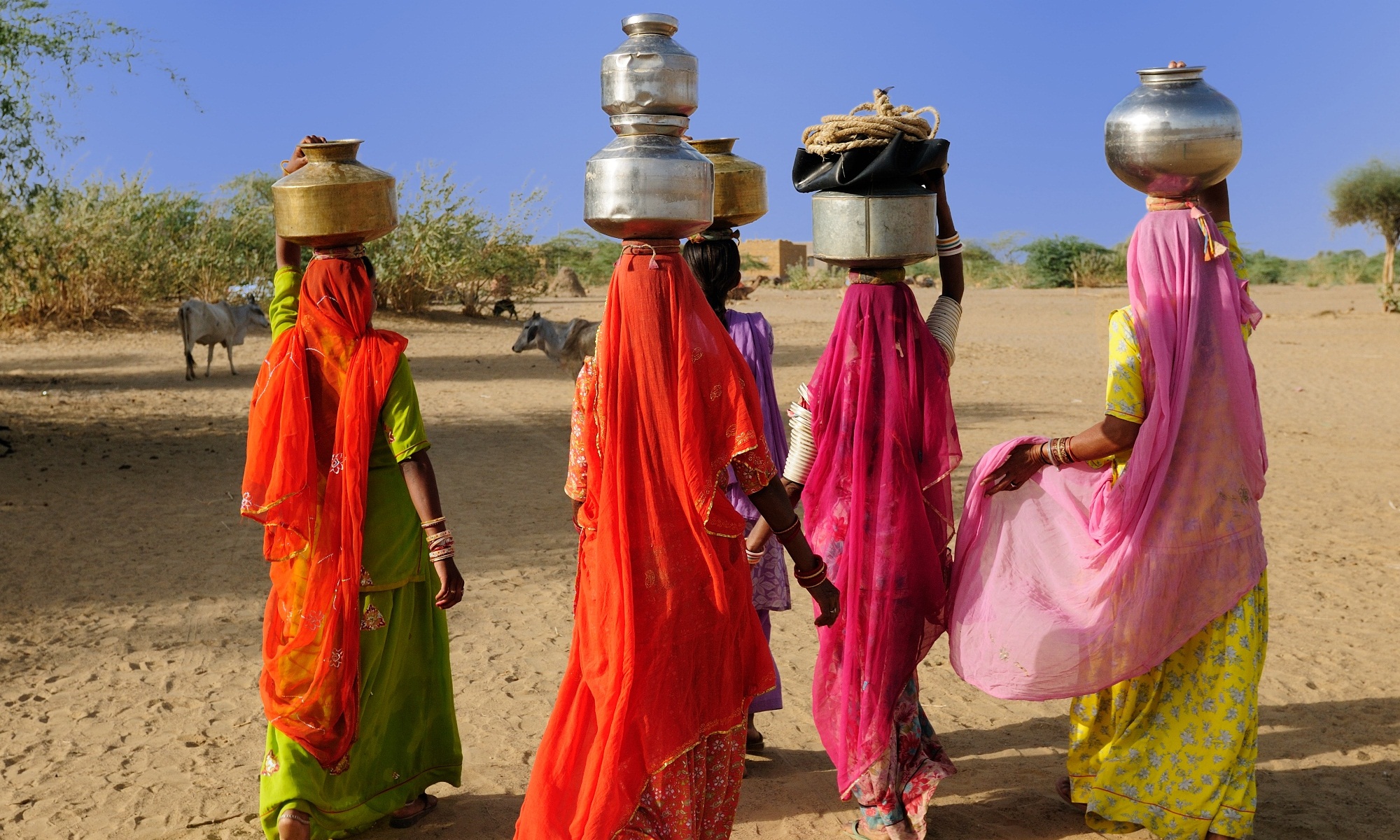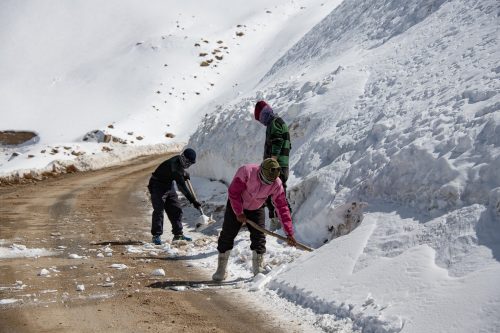
A favorite discussion among passionate travelers is “where to next”? My answer had always been Ladakh, to which most people would get a puzzled look and ask, “Where is that?”
I’m not sure why I felt the need to see this Buddhist region tucked into the Himalayas of northern India.
Maybe it was the remoteness to see a piece of the world unknown to most people. What I did know was the idea of exploring Ladakh had burned a desire into my mind that wasn’t going away.
Digging In My Heels
I had organized a photo workshop to India in March and decided to investigate the options for extending the trip to see Ladakh. The ideal time to visit runs from April to October, when most of the high mountain passes are open, and the weather is pleasant.
I found considerable reluctance from most tour operators to help me. Responses ranged from “it’s the wrong time of year,” “it will be too cold,” and “it’s still winter there, nothing will be open.” Really!
Somehow all the negativity made me dig my heels in deeper, determined to go. Indus Trips, who had made superb arrangements for our photo workshop, took pity on me and said they would help if I was determined to go.
I was leaving nothing to chance, spending hours on the internet researching all options for what I could see and experience in Ladakh. I would use Leh, the capital city, as my base for three days. I hoped to hear morning prayers at one of the monasteries, explore the local vibe of Leh, drive the Khardung La Pass, and stop by local sights to photograph.
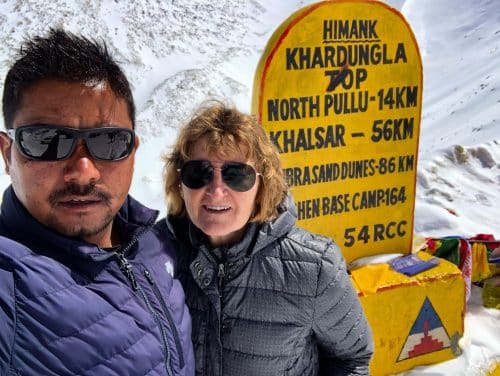
I gave my laundry list to Indus Trips of what I hoped to accomplish and asked that they arrange a guide/driver. I splurged on accommodations and booked my room at the luxurious Grand Dragon Ladakh.
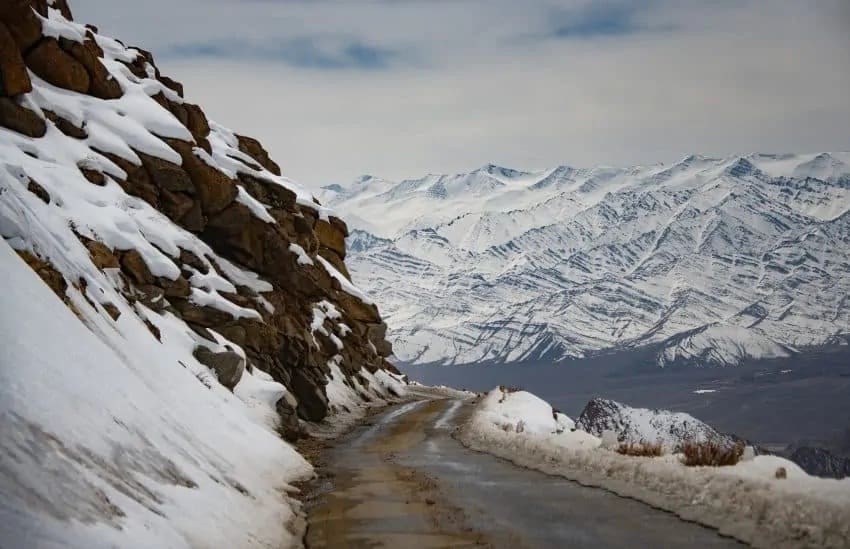
Getting to Ladakh
Getting to Ladakh involves a one-hour plane ride from Delhi. Most of my fellow passengers were men, dressed in cold weather clothing and toting scruffy-looking carry-ons.
They bore the look of tired souls. I learned these men worked on road-building crews and were returning after a holiday break.
With many eyes on me, I felt like a privileged white woman. If only they knew how much empathy I felt for them, knowing how difficult their lives must be. I sensed the scales of equality in life were tipped in my favor.
I had the dreaded middle seat and tried in vain to see if the local in the window seat would change. I knew we would fly over the Himalayas, and I desperately wanted to shoot. I gestured with my camera pointing to the window, but he wasn’t going to budge.
I thought to myself, “ok buddy, I hope you don’t mind having my elbow in your crotch, cause I’m gonna lean over big time to get my shots.” To clarify, I view myself as a very considerate traveler. But Ladakh was my dream journey, I was going to make it all about me for once.
First Impressions
The views over the Himalayas were spectacular, with snow-covered peaks for as far as the eye could see. I got my shots, and my seatmate got a good dose of me in his lap. After we landed and made it through customs, I found Tenzin, my driver and guide (who spoke very limited English) and we were off.
It was a blue-bird sky day, and the air was crisp, unlike the ever-present smog of Delhi. The crowds, traffic, and constant horn honking that defines so much of India were absent. A sense of unhurriedness and tranquility came over me.
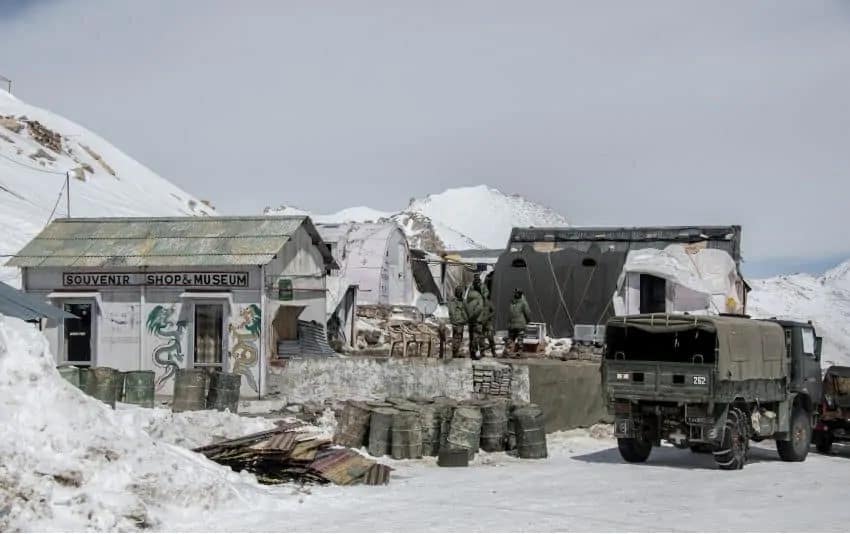
Altitude Adjustments
My first order of business was checking into the Grand Dragon. Leh sits at an altitude of 11,562 feet (a high desert area), so altitude sickness can be an issue. All I had read about this country was to rest on the day of arrival, drink plenty of water, and avoid alcohol.

The hotel staff was adamant that I stay hunkered down in my room for the remainder of the day to make the altitude adjustment. “No can do,” I said to myself. I rested a few hours before Tenzin picked me up, and we were off to explore the capital city.
The Vibe of Leh

It appeared to be market day, and the sidewalks were lined with women sitting on the sidewalk, bundled up in mismatched winter clothing, and selling mostly root vegetables.
A vendor selling dried apricots reached up, and with a sweet smile, placed them in my hand.
When he refused to take any money, I was reminded that the goodness of humans can be found in the most unlikely of places. Older women with weathered faces passed by, some fingering prayer beads and others spinning prayer wheels.
There were several shops selling clothing, medicines, and Buddhist objects used for worship. The neighboring country of Tibet, its Buddhist culture and ways of life had spilled over into Ladakh.
Morning Prayers in Ladakh
My second day in Ladakh focused on the monasteries (also known as gompas) and the local sites around Leh.
With Tensin at the wheel, we hit the road before sunrise for the drive to Thiksey Monastery, so that I could observe morning prayers.
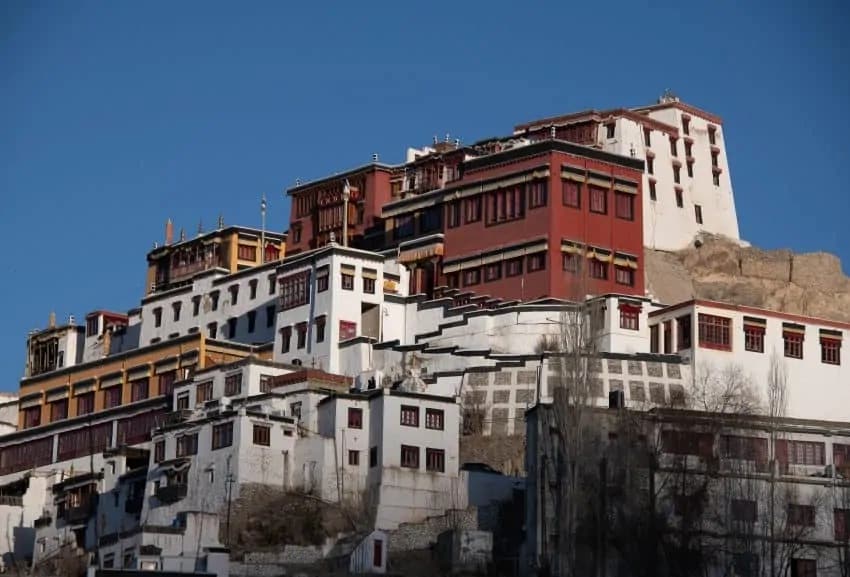
Thiksey Gompa is a 12-story complex clinging to a mountainside that resembles the Potala Palace in Lhasa. As we approached the prayer room, young novice monks were filing in, all wearing the traditional maroon robes.
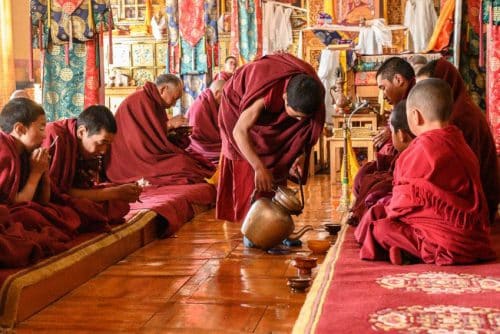
We were welcomed by an older monk who motioned us to some cushions on the perimeter of the room, and soon the chanting of young voices filled the air.
I had read that many Tibetan families in India send at least one child to a monastery to learn about the Buddhist way of life, although it’s a tradition that is dying out.
Full-Fledged Monks
These young boys were novices in training, with some going on to become full-fledged monks.
After the prayers, older kids came around with kettles of butter tea and rice, serving first the young novices, then the elders in the room.
To my surprise, they also offered Tensin and me a cup of butter tea, which we graciously accepted. I admired the monastery for allowing outsiders to observe the sacred rituals. For me, the experience was very humbling.
We filled the remainder of this day of discovery with countryside drives, including stops at gompas, villages, and monuments for photos.
Khardung La Pass
The third day would be a drive on the Khardung La Pass (17,582 feet), one of the world’s highest motorable roads, and the gateway to the Shyok and Nubra valleys.
The route started as a two-lane dry pavement, but narrowed to a single lane the higher we climbed.
Before long, we were driving on a gnarly, snow-covered, icy path to the top. We were the only vehicle on the drive up until we reached the summit.
In a few spots, we encountered a handful of locals chipping away at the gigantic snowbanks with shovels. Was this avalanche patrol?

Tensin didn’t have an answer, although he pointed out a section where an avalanche had come through two weeks prior and had killed some people. I didn’t need to hear that!
Most of the road, devoid of any guardrails, had sheer drop-offs into the valley below. Should some snow breakaway as we passed by, my life would be over.
Tents to Quonset Huts
The Border Road Organization maintains this highway. Their military outpost at the summit was a hodgepodge ranging from tents to Quonset huts and a few military vehicles. A handful of soldiers were working on the road. Strings of colorful prayer flags, hallmarks of the Buddhist culture, fluttered in the wind.
We headed back down after mandatory pictures at the summit, and a stop at a pitiful coffee shack for a cup of lukewarm java. On the way, Tensin invited me to lunch at his family’s home. Without hesitation, I said yes.
Breaking Bread With New Friends
Tensin lives with his sister and mother on a small plot of land outside of Leh. As we pulled up, his mother, sister, and aunt rushed out to meet us and quickly ushered me into their simple dwelling.
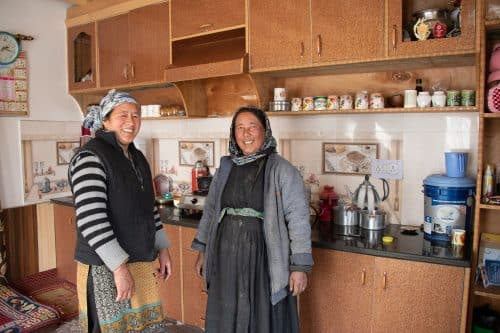
Tensin motioned me to take a seat on the floor in front of a low table, then a cup of tea and some biscuits were offered.
The women stood at a small counter with a portable stovetop, preparing momos and soup, then joined me on the floor for a delicious lunch.
I felt honored to break bread with these strangers who subsist on so little yet willingly share. The best thing to do with the kindness shown to me was to pay it forward.
Watching Tensin’s mom moved me to tears. My mom had passed away unexpectedly two weeks earlier, just one day before boarding a plane for my photo workshop in India.
I knew I had to go on with the trip, so I stuffed my sorrow deep into my heart, and now, in this remote land, it was bubbled up. As I tearfully shared about my mother’s death, Tensin’s mom wrapped her arms around me.
Ladakh’s Life Lessons
Looking back, I can’t say that the three days I spent in Ladakh provided clarity as to my obsession with this country. Three days had reinforced my belief that our environment and the family we are born into shapes our path in life.
I headed home determined to appreciate those things I take for granted – something as simple as shopping inside a clean, well-lit supermarket.
The random acts of kindness shown to me were stark reminders that it doesn’t take much effort to brighten someone’s day by my thoughtfulness – a good life lesson to follow. I had but a small nibble of this Himalayan country.
The desire to see more, especially in a warmer season when all of this region of northern India is open to exploring, calls for a repeat visit.
If looking to explore Ladakh, I recommend Indus Trips (www.industrips.com) to help with arrangements.
There is a $10US per person permit fee to visit Ladakh.
To read the original article please visit – https://www.gonomad.com/166354-ladakh-where-donnie-keeps-coming-back-to
Let us know if you like a Tour. We will be happy to customize any tour to your requirements. You can specify changes you need using the form given below. We will send you a quote by email. For booking related queries you can call Mr.Praveen Kumar at +91 9810954649.
